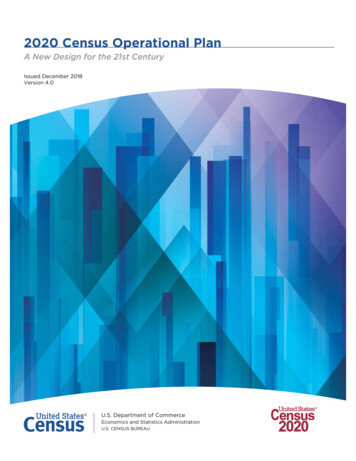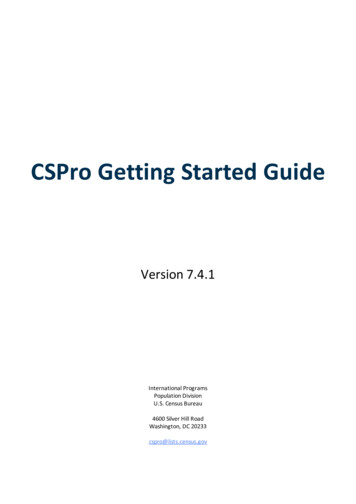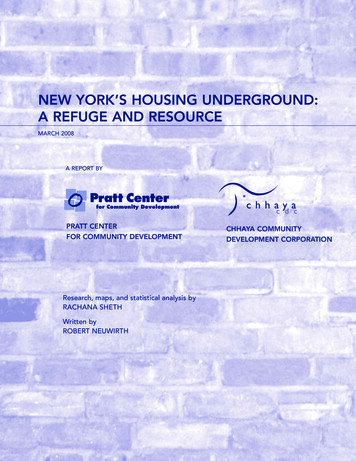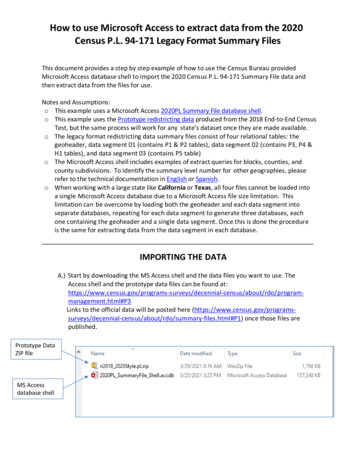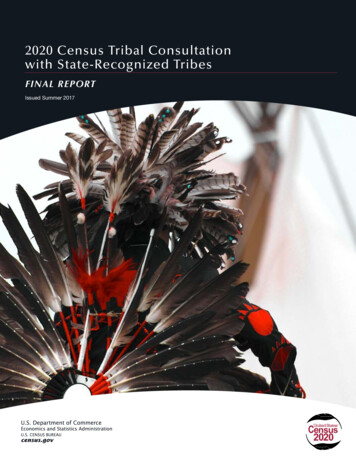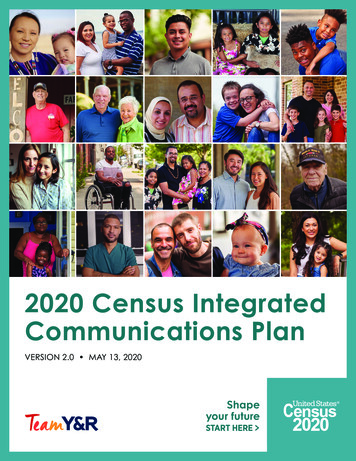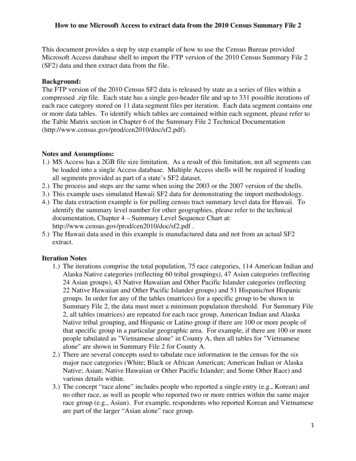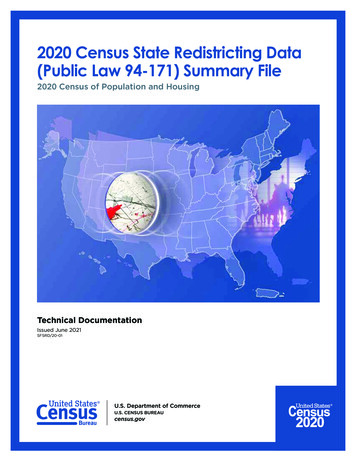
Transcription
Title page goes here.This is a subhead.Month XX, XXXX
The 2020 CensusBriefing for Black/African AmericanMediaWashington, D.C.March 3, 20202
U.S. Census Bureau speakersMichael C. Cook,Sr., Chief, PublicInformation OfficeDale Kelly,Chief of FieldDivisionKendall B. Johnson,Executive Director,2020 Census IntegratedCommunicationsContract
Trusted voices and partnersAustin Patrick,Strategist, TeamY&RMelissa BirdExecutive Director,District Census2020Camille Exum, PrinceGeorge’s County CompleteCount Committee
The decennial census is amassive, multi-billion dollaroperation with significantimplications for every community.
2020 Census PLE TORESPONDESTABLISHWHERE TOCOUNTCount everyone once,only once, and in the right place.TABULATE DATA ANDRELEASE CENSUSRESULTS
The 2020 Census is SafeEasyImportant
The 2020 Census is safe Responses to the 2020 Census are confidentialand cannot be shared with or used by any otherlaw enforcement agency—including local police. Census Bureau employees take a lifetime oath toprotect the personal information of everyrespondent. Any Census Bureau employee thatviolates this law is subject to a penalty of up to 250,000 and/or up to 5 years in prison. Online responses are safe from hacking andother cyberthreats.
The 2020 Census is easy In mid-March, everyone will receive aninvitation in the mail, or hand-delivered bya census employee to their household. You can respond online, by phone or bymail. A toll-free hotline will be available to assistthose with questions or needing languageassistance. Information is also availableonline at 2020census.gov.
Why is the 2020 Census OUNDARIESPUBLICFUNDINGDECISIONSINVESTMENTS,JOBS, SERVICESCOMMUNITYSERVICES
Programs that use Census Bureaustatistics to inform funding Medicare health insurance (Medicaid) for people with low income,including people with disabilities Supplemental Nutrition Assistance Program (SNAP) for low-income people,including disabled and low-income people over 65 Medicare Part B insurance for all people over 65 Highway planning and construction grants Pell Grants for college tuition Housing assistance Head Start and other education grants
JanuaryOperationaltimeline21January 21 – April 30Remote Alaska EnumerationMarch 16 – April 17Update LeaveMarch 12 – July 31Internet Self-Response
Operationaltimeline(continued)April 2 – June 5Group Quarters EnumerationApril 1Census DayMay 13 – July 24Nonresponse Follow-up
Operationaltimeline(continued)December 31, 2020Apportionment Counts delivered to thePresidentApril 1, 2021Redistricting data at block level delivered tostates
The 2020 Census: what to expectDale KellyChief of Field Division
How the 2020 Census will inviteeveryone to respondIn mid-March, every household will receive an invitation to participate in the 2020 Census eitherin the mail, or from a census taker.
What to expect in the mailMarch 12 - 20An invitation to respond online to the 2020 Census.(Some households will also receive paper questionnaires.)March 16 - 24A reminder letter.March 26 - April 3A reminder postcard.April 8 - 16A reminder letter and paper questionnaire.April 20 - 27A final reminder postcard before we follow up in person.
Census questionnaire How many people are living or staying in your home onApril 1, 2020 If there are any additional people staying in your home onApril 1, 2020 that you did not already include Whether the home is owned or rented Your telephone number The name, sex, age, date of birth, race and Hispanic originof each person in the household The relationship of each person in the household to onecentral estionnaire.pdf
2020 CensusSelf-identification of race and Hispanic origin Follows most recent Revisions to the Standardsfor the Classification of Federal Data on Raceand Ethnicity In keeping with OMB standards, the plannedrace and Hispanic origin questions for the 2020Census will follow a two-question format forcapturing race and Hispanic origin
2020 Censusnon-English language supportInternet Self-Response andCensus QuestionnaireAssistanceLanguage Guides (Video and Print)Language GlossariesLanguage Identification alogPolishFrenchHaitian es59 Non-English icTagalogPolishFrenchHaitian hIgboMarathiSinhalaSlovakAmericanSign Language
Who should be counted in thecensus?Everyone living in the United States. You! Children, including newborn babies born by April 1, 2020 Everyone living under your roof.
Specialized outreach approachesCensus taking for special populations: Military and federal employees living overseasand their dependents Group facilities (college dorms, military barracks, nursinghomes, group homes, shelters, psychiatric facilities,correctional facilities) People experiencing homelessness, in shelters or outside.
How to Identify a Census TakerCheck their badge.All U.S. Census Bureau employees willpresent an official ID badge.What to look for:It will include:Their name,Their photograph,A Department of Commerce watermarkAn expiration date.The Census Bureau will never ask for your full Social Security number,bank account number or passwords.
We’re hiring! Recruiting more than 2 millionindividuals to work in theircommunities. Pay rates vary according to location. Schedules are flexible – work 10hours/week or full time! Applicants stay in the pool for theentire census.www.2020census.gov/jobs
The 2020 Census communicationscampaignKendall B. JohnsonExecutive Director,2020 Census Integrated Communications Contract
The Census Bureau goes to greatlengths to educate and inspireresponses, particularly in hard-tocount communities.Communications are a critical partof the operation.
Campaign research 17,500 survey respondents 160 focus groups 13 languages28
Research: Census Barriers Attitudes& Motivations Study (CBAMS)Knowledge Gaps General lack of knowledge about the census’scope, purpose, and constitutional foundationBarriers Connecting census participationto support for local communitiesmay address apathy and lack ofefficacy Apathy and lack of efficacy Privacy concerns Fear of repercussions Distrust of government Few perceived personal benefits Informing the public on the census’scope, purpose, and process mayaddress privacy and confidentialityconcerns and fear of repercussionsMotivators Funding for community needs is the mostinfluential motivator across audiences Services such as hospitals, fire departments, andschools are important to many respondents Engaging trusted voices mayaddress trust-based concerns,especially among the mostskeptical and disaffected
Title page goes here.This is a subhead.Month XX, XXXX
31
Reaching hard-to-countcommunitiesAdvertisingPartner OrganizationsPartnership staff
Campaign phases and timeline1Phase 1: Awareness2Phase 2: MotivationMarch 13 through May 12, 2020(Census Day is April 1, 2020)January 12 through March 12, 2020Bring attention that the 2020 Census isapproaching and educate.Drive participation and action toencourage 2020 Census surveycompletes.Keep the 2020 Census top of mind.3Phase 3: Reminder4Phase 4: Thank YouMay 13 through July 31, 2020September 2020 - BeyondRemind people of the deadlines to drivenon-responder survey completes.Inform the public that the 2020Census is now complete and educatewhere census results can be found(private information will not beshared).Inform people of enumerators forcooperation prior to when theywill come to their door.*Timing for each phase may be subject to change **Alaska (remote campaigns) to launch Phase 1 in January 1, 2020 due to early enumeration
Partners and supporter examples National Newspaper PublishersAssociation (NNPA) National Association of Black Journalists(NABJ) Rainbow PUSH Coalition National Action Network National Council of Negro Women National Coalition for Black CivicParticipation National Association for Equal Opportunityin Higher Education (NAFEO) National Urban League 100 Black Men of America
Reaching Black/African AmericanaudiencesAustin PatrickStrategist, Team Y&R
Black/African American communityresearch insights “Civic duty” does not resonate with this audience as a motivator. Some members of the Black/African American community doubtthat participating in the 2020 Census will make a difference. Safety/confidentiality is a strong concern. Motivated by the potential for census data to inform funding forcommunity improvements and important education and healthprograms.
Community partnersMelissa BirdExecutive Director, District Census 2020
Community partnersCamille ExumPrince George’s County Complete Count Committee
Reporting on the 2020 Census Understand the Census OperationalTimeline and drive stories around thattimeline Cover stories about 2020 Census jobs andrecruiting via social and traditional mediachannels Visit the Census Newsroom www.census.govto sign up for regular updates on the censusoperations timeline, data sources and pressreleases
Response rates mapBeginning in mid-March, the Census Bureau will providethe public with daily data on census self-response rates,available on 2020census.gov.You can use the map to find your 2010 Census responserate and then set a goal for your 2020 Census ResponseRate Challenge. The map will help you track your challengeand see how close you are to achieving your goal.Visit 2020census.gov/en/response-rates to explore theResponse Rates Map.
2020census.gov
Tangible benefits toolkitUnderstand how the census can help shape yourcommunity’s future.Includes: Data tools and resources Stories on Community Benefits PSAs, FAQs Programs influenced by Census Bureau data
Join the conversation ureau
Media Q&A
Thank you.Get involved in your community today.@uscensusbureau #2020Census
Timeline and drive stories around that timeline Cover stories about 2020 Census jobs and recruiting via social and traditional media channels Visit the Census Newsroom www.census.gov to sign up for regular updates on the census operations timeline, data sources and press releases Reporting on the 2020 Census
